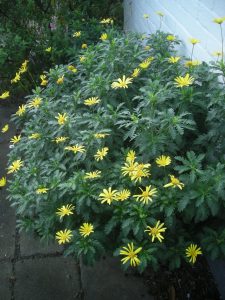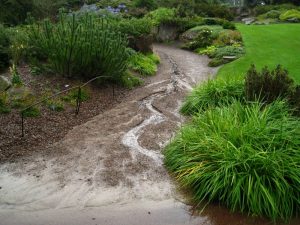Following the coldest and snowiest December (2010) on record, the respite from fresh snow over the New Year period lasted until 6.00pm on the evening of January 7th. Yes, at 7.30am on the 8th January, we were snowploughing the Garden’s roads again. Over the New Year the weather had been dry and the temperature a few degrees above freezing. With the snow melting there were signs of emerging Snowdrops. Frosty nights and crunchy snow underfoot then returned.
The Hamamelis were the main survivors sending out bloom as the lingering snow of the coldest winter, since the snowdrifts of winter 1962-3, melted. The paper thin petals contain minimum water compared to those of the Viburnum x bodnantense hybrids which were slaughtered by the devastating cold. So, as gardeners, we were pleased to see temperatures rising and appreciate the lengthening days as spring unfolded.
The lawns were slow into growth and just as the clocks were about to change and the longer evenings arrive a spell of dry settled weather commenced. This added to the slow recovery of the lawns. We eventually made the first cut on the 4th April, the latest date to commence mowing for the 24 years I have kept these records. In contrast, the Beech hedge leafed out from the 10th April, the earliest date I have recorded.
In the middle of April a mature specimen of Staphyllea pinnata flowered profusely. This was the first time this tree had flowered so noticeably, covered in pendulous racemes of creamy white blossom. This was just one, among many, of the tree species that flowered this year; outdoing previous year’s displays.
Easter became a pink season due to the amount of ornamental Cherry blossom; the traditional Easter Daffodil had flowered and faded.
Woody material continued to flower profusely into mid summer.
Early June saw gale force winds batter the tree collection. As the collection was in full leaf there was significant damage with limbs torn down and a couple of small trees uprooted.
The longest day again disappointed, rainfall and cloud cover. Not a sight of the sun. Just to keep it in perspective there was a frost on June 10th recording – 0.58C
The weekend commencing Friday July 8th saw torrential storms with thunder and lightening. Silt washed down and blocked drains and a lightening strike disabled the alarm panel controlling the fire alarms and climate controls for the glasshouses. Some areas of Edinburgh experienced flash floods with consequential damage. In total over the three days 43.6mm of rainfall was recorded falling in the Garden. That compares to 112.6mm throughout July 2010.
Summer was a wash out, cloud, torrential rain and when the sun made brief appearances it was of a burning intensity that sent those follicly challenged dashing for the sun cream. Home grown tomatoes did not have the sweetness of previous sun drenched years and spinach grew like rhubarb.
During August the lawns puddled and squelched as footsteps were placed on them. Mowing became a challenge due to the weight of the machines running over the lawns. Interestingly, seedlings of Plantago major ‘Rubrifolia’ appeared in the lawns. These easily spotted weeds have originated from the red leaved parent colony in the demonstration garden. They had not been noticed as a lawn weed at RBGE in seasons past. Here at the Garden we keep an eye on invasive species and an initiative to look through the Gardens database of living plants and reduce or de-access those plants which are deemed to be invasive is underway.
September arrived with early signs of autumn colour. There was sporadic flowering in many woody species, probably caused by the cold summer and low light levels. The plants confused into believing they had gone through winter and it was now spring and the season to send out flowering shoots. At the garden we were of the opinion we lived through a continual winter this year.
The last few days of September saw a period of warm sunny weather that was all too brief but most welcome. Visitor numbers peaked as the Edinburgh populace strolled through the green space.
It brought its own horticultural problems as the temperature in poly tunnels rose and humidity increased. The foliage of potatoes planted for a Christmas day lunch succumbed to fungal infection and mildew was found on salad leaves.
Ventilation, good air circulation and less water splash is the key to preventing these outbreaks.
The afternoon of 19th October became colder and on the morning of the 20th we had the first frost (-1.58oC ) whitening the lawns. This; coincidentally, is the same date as the first frost of 2010.
November continued mild; the Gardens’ weather station recorded the highest daily temperature in Scotland according to the Lothian’s area of the Met office, 17.2oC on Thursday 3rd November.
One of the downsides of the continuing mild weather are the midges. The team at Benmore were plagued into the tail end of the year. Highly unusual for the midge population to be active so late into the year.
Storm force wind heralded the start of December. The Garden closed twice due to the gales this month and a fall of snow melted overnight as we were reaching the shortest day. A benign end to the year, birds attempting the dawn chorus as we walk to work, cloud cover trapping the warmth, only a few days of frost and the incessant rain. One plant that is taking advantage of this mild weather is Euryops chrysanthemoides, this native South African is flowering with profusion in a sheltered corner of the back yard.
In conclusion, it has been a year that has shown extremes of weather stretching the limits of horticultural practices. One word of advice, the snowdrop and daffodil foliage is well advanced; take the opportunity to work through the borders now, any delay and your boots will crush these spring flowers.
Wrap up warmly and enjoy the New Year celebrations.
Best wishes for 2012.


